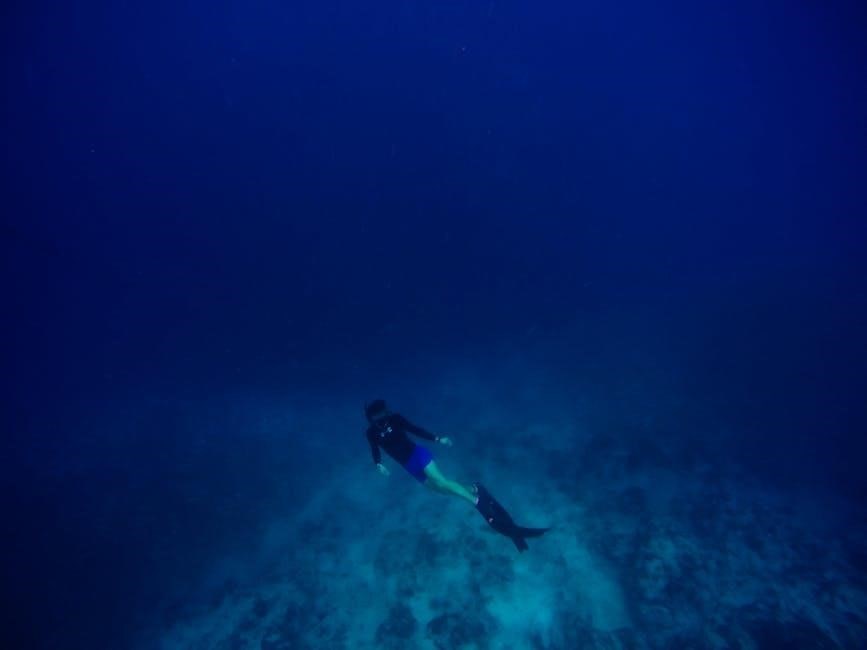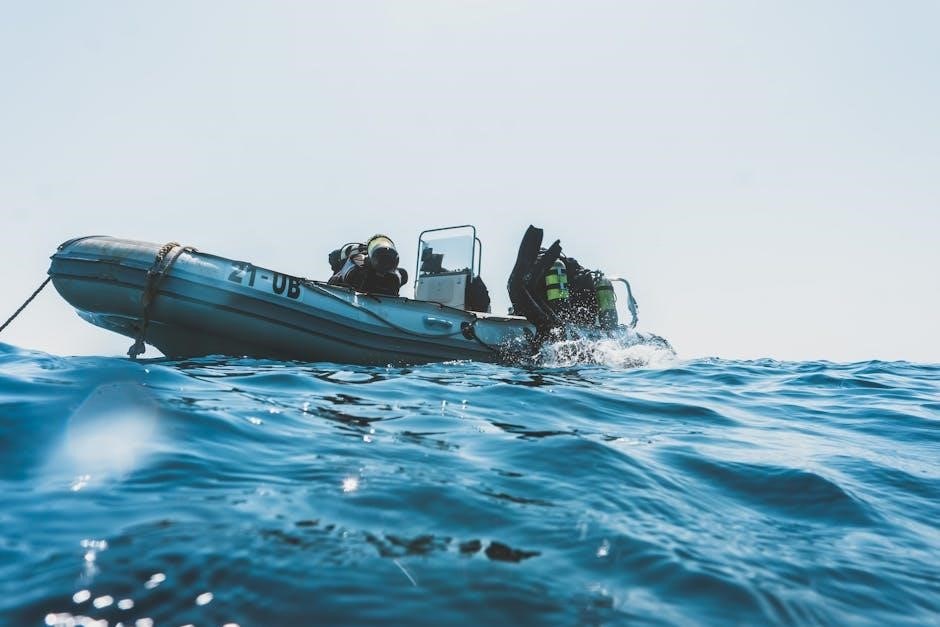The PADI Open Water Diver Manual is a comprehensive guide for new divers, covering essential topics like the underwater world, dive equipment, and safety practices. Available as a free PDF, it integrates seamlessly with the PADI course, ensuring a structured learning experience. This manual is crucial for understanding scuba diving fundamentals and preparing for open water dives. It emphasizes safety, dive planning, and environmental awareness, making it a vital resource for all aspiring divers.
Overview of the PADI Open Water Diver Certification
The PADI Open Water Diver Certification is the world’s most recognized scuba diving credential, offering a comprehensive pathway to becoming a confident underwater explorer. Designed for beginners, this certification is obtained through a structured course combining classroom instruction, confined water training, and open water dives. It equips divers with fundamental knowledge and practical skills, such as using dive equipment, understanding safety procedures, and navigating underwater environments. With over 25 million certifications issued globally, the PADI Open Water Diver program is trusted by divers and instructors alike. The certification process ensures adherence to rigorous safety standards and environmental awareness, making it a cornerstone for responsible and enjoyable diving experiences worldwide.
Importance of the PADI Open Water Diver Manual
The PADI Open Water Diver Manual is an indispensable resource for aspiring divers, serving as the foundation of the certification process. It provides detailed explanations of diving principles, safety guidelines, and practical skills, ensuring a thorough understanding of scuba diving. The manual’s structured approach helps learners progress logically, from basic concepts to advanced techniques. By emphasizing safety, environmental awareness, and proper equipment use, it prepares divers for real-world scenarios. Additionally, the manual’s integration with the PADI Open Water Diver course ensures a seamless learning experience. Its availability in digital formats, including PDF, makes it accessible and convenient for modern learners. This resource is essential for building confidence and competence, making it a critical component of diver education.

Structure of the PADI Open Water Diver Manual
The manual is divided into clear chapters, starting with foundational concepts like the underwater world and progressing to dive equipment and procedures, ensuring a logical learning flow.
Chapters and Sections of the Manual
The PADI Open Water Diver Manual is organized into five main chapters, each focusing on specific aspects of scuba diving. Chapter One introduces the underwater world, exploring aquatic life and environments. Chapter Two details dive equipment, explaining its proper use and maintenance. Chapter Three covers dive planning and procedures, emphasizing safety and preparation. Chapter Four focuses on safe diving practices, including emergency protocols and environmental responsibility. The manual also includes appendices with the Recreational Dive Planner (RDP) table and dive planning worksheets. Each section is designed to build knowledge progressively, ensuring a thorough understanding of scuba diving fundamentals.
Key Topics Covered in the Manual
The PADI Open Water Diver Manual covers essential topics for new divers. It begins with an introduction to the underwater world, discussing marine life and ecosystems. The manual explains dive equipment, including selection, assembly, and maintenance. Dive planning is emphasized, with detailed instructions on using the Recreational Dive Planner (RDP) to ensure safe depth and time limits. Safety practices are a priority, with sections on emergency procedures, buddy checks, and dive signals. Additionally, the manual addresses environmental responsibility, such as avoiding marine life disturbance and proper buoyancy control. This comprehensive approach ensures divers gain the knowledge needed for safe and enjoyable underwater experiences. The content is structured to be engaging and accessible for all learning styles, making it an invaluable resource for both students and instructors.

Content of the PADI Open Water Diver Manual
The manual covers the underwater world, dive equipment, planning, and safety practices. It also includes environmental responsibility and emergency procedures, ensuring a well-rounded education for new divers.
The Underwater World
The PADI Open Water Diver Manual introduces divers to the fascinating underwater world, focusing on marine life, ecosystems, and environmental responsibility. It explores coral reefs, kelp forests, and other habitats, explaining the importance of conservation. The manual highlights how divers can interact with marine life responsibly, emphasizing the role of divers in preserving these ecosystems. By understanding the underwater environment, divers gain a deeper appreciation for the beauty and fragility of marine life, fostering a commitment to sustainable diving practices. This section is essential for building awareness and respect for the underwater world, ensuring that divers become stewards of the ocean. The content is both educational and engaging, preparing students for their diving adventures while promoting environmental care.
Dive Equipment and Its Use
The PADI Open Water Diver Manual provides a detailed overview of dive equipment, explaining its purpose, proper use, and maintenance. Essential gear includes masks, snorkels, fins, BCDs, regulators, and tanks. The manual emphasizes the importance of selecting equipment that fits correctly and suits individual needs. It also covers the assembly and disassembly of gear, highlighting safety checks to ensure everything functions properly. Students learn how to use their equipment effectively during dives, including techniques for buoyancy control and emergency procedures. Understanding and caring for dive equipment is crucial for safe and enjoyable diving experiences, making this section a cornerstone of the manual. Proper equipment handling is stressed to prevent accidents and extend gear lifespan.
Dive Planning and Procedures
Dive planning is a critical component of safe and enjoyable diving, as outlined in the PADI Open Water Diver Manual. The manual emphasizes the importance of creating a detailed dive plan, including depth limits, bottom time, and safety stops. Divers learn how to use the Recreational Dive Planner (RDP) to calculate safe limits based on their certification level and environmental conditions. Proper procedures for ascent, descent, and navigation are also covered. The manual stresses the need for buddy checks and pre-dive briefings to ensure everyone is prepared. By following these guidelines, divers can minimize risks and maximize their underwater experiences. Effective planning and adherence to procedures are essential for a safe and successful dive. The manual provides clear, practical instructions to help divers master these skills.
Safe Diving Practices
The PADI Open Water Diver Manual places a strong emphasis on safe diving practices to ensure a risk-free experience for all divers. Key principles include breathing continuously underwater, avoiding rapid ascents, and never diving alone. The manual highlights the importance of buddy checks and staying within depth and time limits as specified by the Recreational Dive Planner (RDP). It also covers emergency procedures such as dealing with equipment failures and managing cramps or panic situations. Additionally, divers are taught to be aware of their surroundings and respect marine life to promote sustainable diving. By adhering to these guidelines, divers can significantly reduce the risks associated with scuba diving and enjoy a safe, enjoyable experience underwater. These practices are essential for building confidence and competence in new divers.

How to Use the PADI Open Water Diver Manual
The PADI Open Water Diver Manual is a comprehensive guide for independent study, integrating seamlessly with the PADI course. It’s available offline, ensuring accessibility for all learners. Follow the structured content, use the Recreational Dive Planner (RDP), and complete all knowledge reviews to master safe diving practices effectively.
Study Tips for the Manual
To effectively study the PADI Open Water Diver Manual, start by breaking down the content into manageable sections. Focus on understanding key concepts like the underwater world and dive equipment. Use the integrated videos in the digital version to visualize techniques. Review the Recreational Dive Planner (RDP) table for safe dive planning. Complete all knowledge reviews at the end of each chapter to reinforce learning. Take notes on important safety guidelines and diving procedures. Utilize the offline access feature to study anywhere, even without internet. Schedule regular study sessions to ensure consistent progress. After completing the manual, review diving scenarios to apply what you’ve learned. This structured approach will help you master the material and prepare confidently for your certification dives.
Integration with PADI Open Water Diver Course
The PADI Open Water Diver Manual is seamlessly integrated with the PADI Open Water Diver Course, serving as the primary study material. It aligns with the course structure, covering theoretical knowledge that complements classroom instruction, confined water training, and open water dives. The manual is divided into chapters that correspond to course modules, ensuring a logical progression of learning; Key topics, such as dive planning and safety practices, are reinforced through knowledge reviews and practical applications. The manual also includes the Recreational Dive Planner (RDP) table, which is essential for safe dive planning, and works in conjunction with the PADI Skill Practice and Dive Planning Worksheets.
By studying the manual alongside the course, students gain a comprehensive understanding of scuba diving principles and procedures. The digital version of the manual, available for offline access, allows students to review material anytime, enhancing their learning experience. This integration ensures that students are well-prepared for both the theoretical and practical aspects of the course, ultimately leading to successful certification.
Role of the Recreational Dive Planner (RDP)

The Recreational Dive Planner (RDP) is a crucial tool within the PADI Open Water Diver Manual, designed to help divers plan safe and enjoyable dives. It provides guidelines for maximum depth and bottom time, allowing divers to avoid decompression sickness and stay within safe limits. The RDP is integrated into the manual as a practical resource for students to learn how to plan dives effectively. It is essential for both training and real-world diving, ensuring that divers understand how to use time and depth limits responsibly. The RDP is also included in the digital version of the manual, making it easily accessible for offline use. This tool is a cornerstone of safe diving practices, emphasizing the importance of careful planning to enhance diving experiences and safety.

Accessing the PADI Open Water Diver Manual
The PADI Open Water Diver Manual is easily accessible as a downloadable PDF from official sources like PADI.com or through certified dive centers. Digital versions are available for offline use, ensuring convenience for students worldwide.
Downloading the PDF Version
Downloading the PADI Open Water Diver Manual as a PDF is straightforward and convenient. The manual is available for free download from official sources such as the PADI website or through certified PADI dive centers. This digital format allows divers to access the material offline, making it ideal for independent study and preparation. The PDF version is fully searchable and includes interactive features, enhancing the learning experience. Additionally, the manual is compatible with various devices, ensuring accessibility anywhere. By downloading the PDF, students can easily review key concepts, dive planning procedures, and safety guidelines before their practical training begins. This flexibility makes the PDF version a valuable resource for aspiring divers worldwide.
Official Sources for the Manual
The PADI Open Water Diver Manual is available exclusively through official PADI channels, ensuring authenticity and quality. The primary source is the PADI website, where students can access the digital version after enrolling in a course. Additionally, certified PADI Dive Centers and Resorts worldwide provide the manual as part of their training programs. For instructors, the PADI Pros Site offers downloadable resources, including the latest editions of the manual. The Internet Archive also hosts older versions of the manual for reference. Always verify the source to ensure you receive the most up-to-date and accurate information, as unauthorized versions may lack critical updates or safety guidelines.
Digital Platforms and Offline Access

The PADI Open Water Diver Manual is accessible via various digital platforms, ensuring flexibility for learners. The PADI Open Water Diver Touch is a popular digital option, offering integrated videos and interactive content. Students can also download the manual as a PDF for offline access, ideal for areas with limited internet connectivity. Offline access allows divers to study independently, even without a stable connection. Additionally, platforms like the PADI Pros Site provide downloadable resources for instructors. The manual is also available through the Internet Archive, making it widely accessible. These digital options ensure that students can engage with the material anytime, anywhere, while maintaining the quality and safety standards of PADI training.

Additional Resources and Supplements
Beyond the manual, divers can access the PADI Open Water Diver Video, which complements the text with visual demonstrations. Log books and dive planning worksheets are also available for practical application. Advanced reading materials and safety guidelines further enhance understanding and preparedness for safe diving practices.
PADI Open Water Diver Video

The PADI Open Water Diver Video is a complementary resource to the manual, offering visual and interactive learning. It covers essential topics like safety procedures, equipment usage, and the underwater environment. The video format helps divers grasp complex concepts through demonstrations, making it easier to understand and retain information. It also includes practical scenarios and real-life applications, enhancing the learning experience. Designed to align with the manual, the video ensures a comprehensive understanding of diving principles. Available in digital formats, it integrates seamlessly with the PADI Open Water Diver Touch, providing offline access for convenient study. This resource is invaluable for visual learners and those seeking to reinforce their knowledge before practical training.
Log Book and Dive Planning Worksheets
The log book and dive planning worksheets are essential tools for documenting and organizing dives. These resources allow divers to track their progress, record dive details, and plan future dives safely. The log book serves as a personal history of dives, including conditions, depths, and observations, while the worksheets help calculate safe limits for depth and time. Both tools are often provided in digital formats alongside the PADI Open Water Diver Manual, making them easily accessible. They reinforce safe diving practices and help divers develop good habits from the start. By using these tools, divers can ensure that every dive is well-planned and executed, contributing to a lifetime of safe and enjoyable diving experiences.

Advanced Reading and Safety Guidelines
The PADI Open Water Diver Manual includes advanced reading and safety guidelines to ensure dives are conducted safely and responsibly. These guidelines emphasize the importance of understanding risk management, emergency protocols, and environmental conservation. Divers are encouraged to review these sections thoroughly to enhance their skills and awareness. The manual also provides detailed information on how to handle diving emergencies and navigate challenging underwater conditions. Additionally, it highlights best practices for marine conservation, such as avoiding contact with coral reefs and not disturbing marine life. By adhering to these guidelines, divers can minimize risks and contribute to sustainable diving practices. These advanced resources are designed to empower divers with the knowledge and confidence needed for a lifetime of safe and enjoyable diving experiences.
The PADI Open Water Diver Manual is a foundational guide for new divers, offering comprehensive insights into safe diving practices, equipment use, and environmental awareness. Completing it marks the beginning of a lifelong journey in scuba diving, empowering divers with essential knowledge and skills for future adventures.
Final Thoughts on the PADI Open Water Diver Manual
The PADI Open Water Diver Manual is an indispensable resource for aspiring divers, offering a detailed and structured approach to learning scuba diving. Its comprehensive coverage of topics, from the underwater world to safe diving practices, ensures that students gain both theoretical knowledge and practical skills. Available in PDF format, it provides flexibility for modern learners, allowing them to study independently or integrate it with classroom instruction. The manual’s emphasis on safety, environmental responsibility, and dive planning makes it a cornerstone of the PADI Open Water Diver course. By completing this manual, divers are well-prepared to embark on their underwater adventures with confidence and competence.
Next Steps After Completing the Manual
After finishing the PADI Open Water Diver Manual, students should proceed to the practical training sessions. This includes confined water dives to practice skills and open water dives to apply knowledge in real conditions. Completing the manual ensures a smooth transition to hands-on training, where divers refine their techniques under instructor supervision. Additionally, students can review the PADI Open Water Diver Video for reinforcement. Upon successfully completing all components, divers receive their certification, unlocking access to dive sites worldwide. Continuing education through Advanced Open Water courses is also recommended to further enhance skills and explore specialized diving areas.
